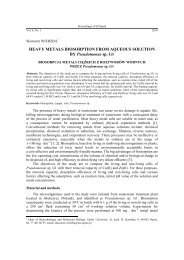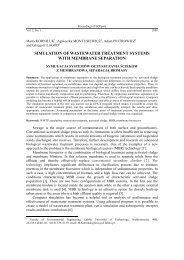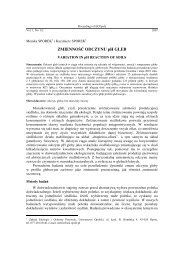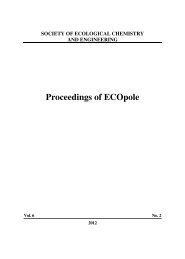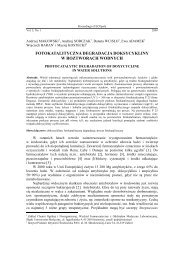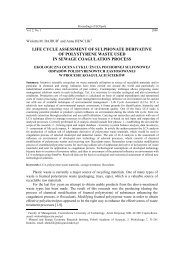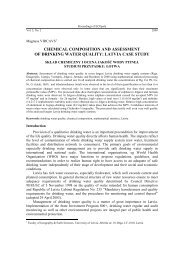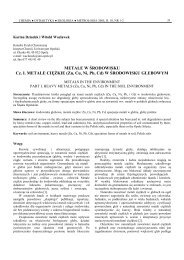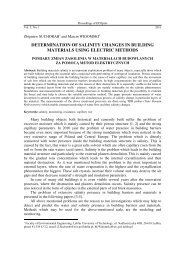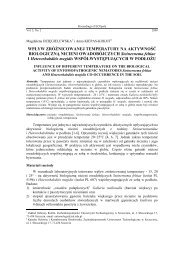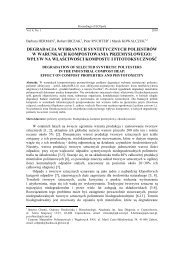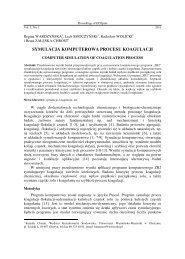ENVIRONMENTAL IMPACT OF BIOETHANOL PRODUCTION
ENVIRONMENTAL IMPACT OF BIOETHANOL PRODUCTION
ENVIRONMENTAL IMPACT OF BIOETHANOL PRODUCTION
You also want an ePaper? Increase the reach of your titles
YUMPU automatically turns print PDFs into web optimized ePapers that Google loves.
68<br />
Joanna Marszałek and Władysław Kamiński<br />
When analysing the literature on the subject, it is possible to identify concrete trends in<br />
the development of pervaporation in ethanol dehydration industry. The PV installation can<br />
be an independent, final stage of dehydration (in order to overcome the azeotropic point),<br />
a direct stage after fermentation process (to concentrate the ethanol below the azeotropic<br />
concentration) or an element of a hybrid solution combined with the presently used<br />
techniques (distillation and dehydration on molecular sieves).<br />
In literature there are many examples of hybrid processes of pervaporation with<br />
distillation [19, 21, 22]. Such hybrid processes enable savings of operating costs (lower<br />
energy demand, not use of additives) but not always of investment outlays (process<br />
complexity and high membrane prices). The development of hybrid processes of<br />
distillation-pervaporation and broad applications in industry will depend not only on high<br />
process efficiency but first of all on reduction of the membrane cost. The hybrid systems<br />
will bring about economic advantages at long-term processes but they are not profitable in<br />
the case of small ethanol dehydration systems.<br />
Beside building of new ethanol dehydration systems based on hybrid processes of<br />
distillation-pervaporation, producers offer also implementation of the pervaporation in the<br />
already existing installations [15]. The PV module can be placed between the distillation<br />
and azeotropic column, this will be a double increase of efficiency and related reduction of<br />
energy cost, dehydration costs, more efficient use of the existing system and a possibility to<br />
control the PV module. Similarly, the PV module can be connected to the already existing<br />
dehydration on molecular sieves, this will cause an increase of process efficiency and the<br />
quantity and quality of water removed, reduction of product recirculation degree and energy<br />
consumption. Just this last application that consists in placing PV between distillation and<br />
adsorption on molecular sieves, can bring in the future the biggest economic benefits in the<br />
process of ethanol dehydration.<br />
Reduction in greenhouse gas emissions<br />
The estimation of greenhouse gas and energy balances of bioethanol is complex. For<br />
comparison with fossil fuels the full fuel cycle must be considered: production which<br />
required inputs and combustion which is considered to be CO2-neutral. The final<br />
accounting is country-specific and is a function of raw material cultivated, the associated<br />
agricultural yield and utilisation of by- and co-products.<br />
Table 2<br />
Overview of CO2 eq. emissions (cultivation, production, distribution and vehicle emissions) saving from<br />
bioethanol compared with reference fossil fuel vehicle [23]<br />
Feedstock<br />
CO2 eq. emission savings<br />
[g/km] [Mg/1000 dm 3 ]<br />
Sugar crops 90 1,2<br />
Starch crops 30 0,4<br />
Lignocellulosic crops 183 2,5<br />
Lignocellulosic residues 191 2,6<br />
Brazilian sugarcane 212 2,9<br />
Table 2 presents total greenhouse gas emissions weighted in terms of their global<br />
warming potentials, as a result of utilising bioethanol over the corresponding fossil fuel.<br />
Use of European bioethanol yields a CO2 emissions savings of 13÷83% compared with



